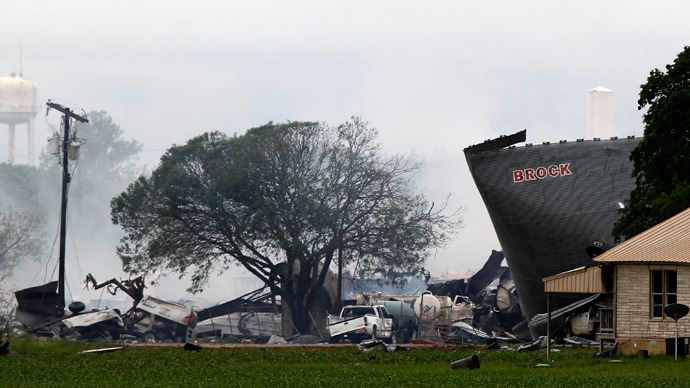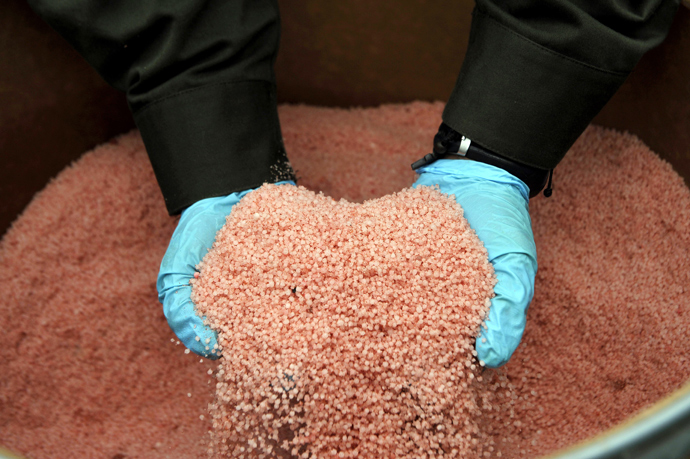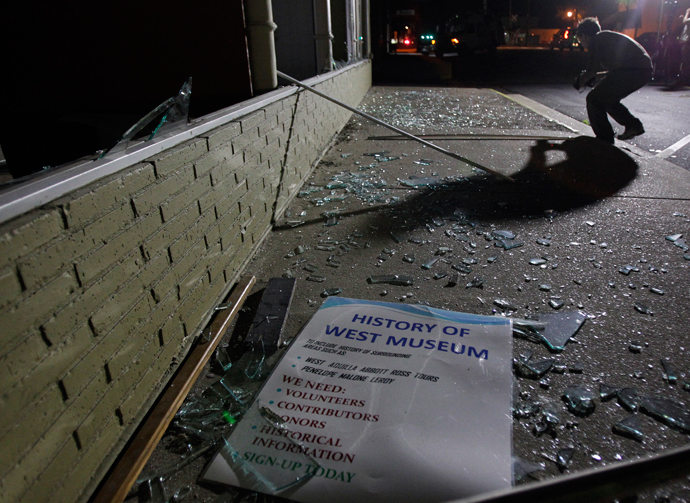Ammonium nitrate mixed with negligence behind Texas fertilizer plant explosion – experts

The massive explosion at a fertilizer plant near Waco, Texas, must have been caused by ammonium nitrate, and couldn’t have gone off without negligence by the facility’s employees, chemists who talked to RT about the incident agree.
The blast occurred on Wednesday night and was so powerful that it
caused a 30-meter-fireball and was registered as a 2.1 magnitude
quake by seismologists.
Police say between five and 15 people are estimated to have been
killed in the disaster so far, but there are fears that the
overall death toll will reach dozens.
More than 160 people have been taken to hospitals, with 24 of
them in critical conditions. The city of West, which neighbors
the plant, is evacuated due to the contamination by toxic fumes.
“The most likely cause of the powerful explosion is the ammonium
nitrate, a fertilizer and pesticide, which is also a powerful
explosive and is known to have caused quite a number of disasters
around the world,” UK chemist Christopher Busby said.
“America’s most deadly disaster, in Texas City in 1947,
happened when a fire detonated 2,300 tons of ammonium nitrate
stored on a ship.”
The expert added that apart from the damage from the blast itself
and the fire it started in the neighborhood, the incident poses
other risks to health. For instance, the Texas plant stored large
amounts of ammonia, a gas used to produce ammonium
nitrate.

“Ammonia is very toxic. It’s a respiratory irritant and it would cause serious upper respiratory tract problems. And it’s also produced when ammonium nitrate itself is heated up. If you heat it up to about 3,500 degrees, it dissociates into ammonia and nitride acid. These two would be quite toxic fumes to anyone inhaling them,” he explained.
Doctor John Price, a professor of mechanical engineering from Australia, stressed that such a larger amount of ammonium nitrate shouldn’t have been stored so close to an inhabited area.
“Well, the question is the ammonium nitrate,” he said. “Now, the quantities of ammonium nitrate that exploded during this event is about, I would say, something in the order of the hundred tons as the ammonium nitrate exploded, which means that was being stored only in the next block on the side of the town. And it resulted that the explosion has ripped through the town with a very strong pressure pulse, which has damaged many buildings.”
He also commented on the footage of the blast, speaking about its possible causes and pointing out some lethal mistakes which were made as the crisis was tackled.
“People were watching the fire from a distance of about 1km from the plant. The fire was very large at that stage and what happens is the fire then goes underneath probably one of the ammonium nitrate storage vessels and eventually heats it up until it explodes. It takes about half-an-hour to an hour for fire to explode in an ammonium nitrate storage vessel."

“So this is what has happened, that the fire has got out of
control and basically heated up the vessel. What seems to me to
be wrong about this whole incident is that instead of evacuating
the plant, when the fire establishment could not control it,
there seemed to be brought up more and more fire people and they
were putting them at risk. I don’t know, it sounds as if there
have been a lot of deaths among fire people,” he added.
The chief safety expert at the Russia’s Nitrogen Industry
Institute, Igor Solovyev, reminded that there haven’t been any
serious accidents at fertilizer plants in half a century and that
serious violations of safety arrangements must have led to the
Texas explosion.
”The burning of some flammable materials could’ve caused the
blast,” he said.
“Undoubtedly, the human factor is to blame here. It’s 100 per
cent. There aren’t that many things, which can explode at the
fertilizer production. The ammonium nitrate or saltpeter is,
possibly, the only one. The explosions of the ammonium nitrate
stated occurring about 80 years ago when the technologies were
only being developed and the switch to large-scale produce was
made. Back then it happened due to the lack of information. But
there were no such explosions during the last 50 years.
“The fire-safety rules must’ve been violated. I don’t know about
the US, but in Russia the organic, flammable materials are
forbidden from being stored together with ammonium nitrate. They
could’ve simply brought some timber and organize a temporary
storage. If it caught fire and the saltpeter was around –
especially, if it was in an enclosed space – it could’ve promoted
the detonation,” Solovyev added.
Dr. Jerry P. Purcell, a safety engineering expert, stressed that
accident in the town of West is the first explosion that he can
recall in Texas from a fertilizer manufacturer.
“A quick search of the OSHA Accident Investigation summaries for
refineries does not show any other multiple-fatality
incidents from similar events in the recent years.”
He told RT that he expects heightened enforcement of the OSHA Process Safety Standard in the next
year. “This standard requires those businesses that deal
significant quantities of ‘highly hazardous chemicals' to
implement several safety analyses and to carefully document any
changes in procedures (like piping, temperature and pressure
controls).”
“If Texas had been a ‘State
Plan’ state, I might have expected Federal OSHA to revoke the
‘State Plan’ authorization, but workplace safety in Texas was
already under the jurisdiction of Federal OSHA.”
The statements, views and opinions expressed in this column are solely those of the author and do not necessarily represent those of RT.












